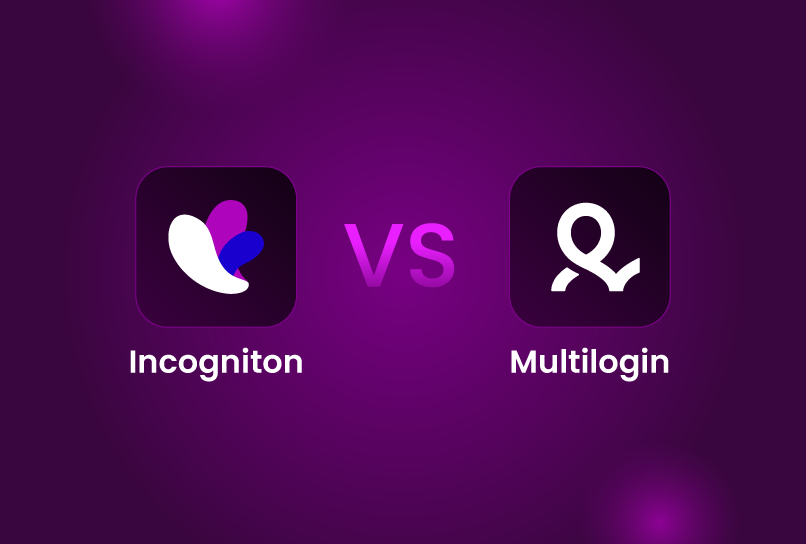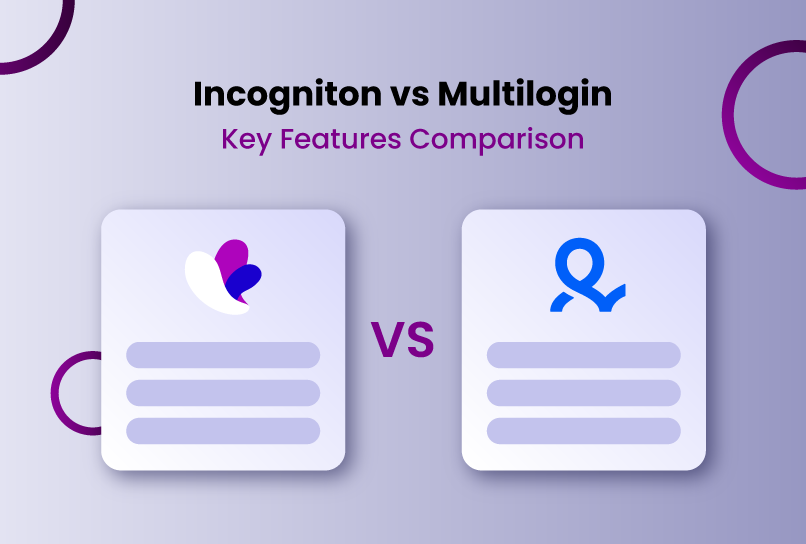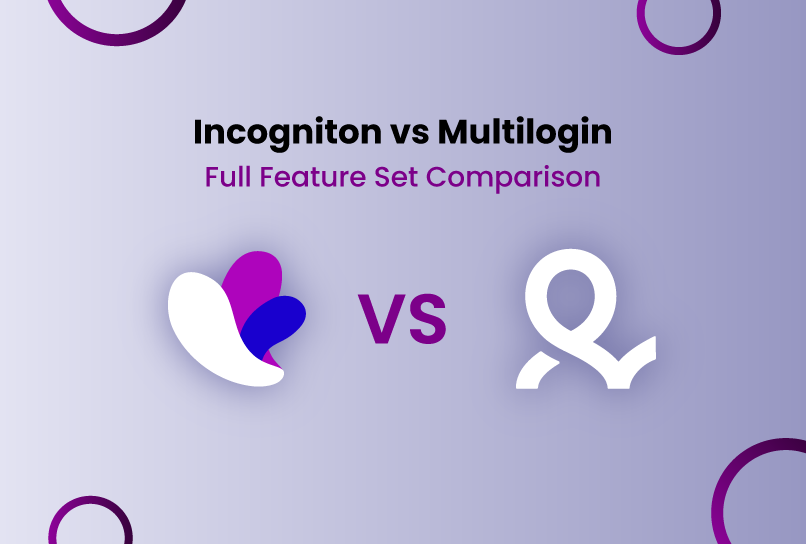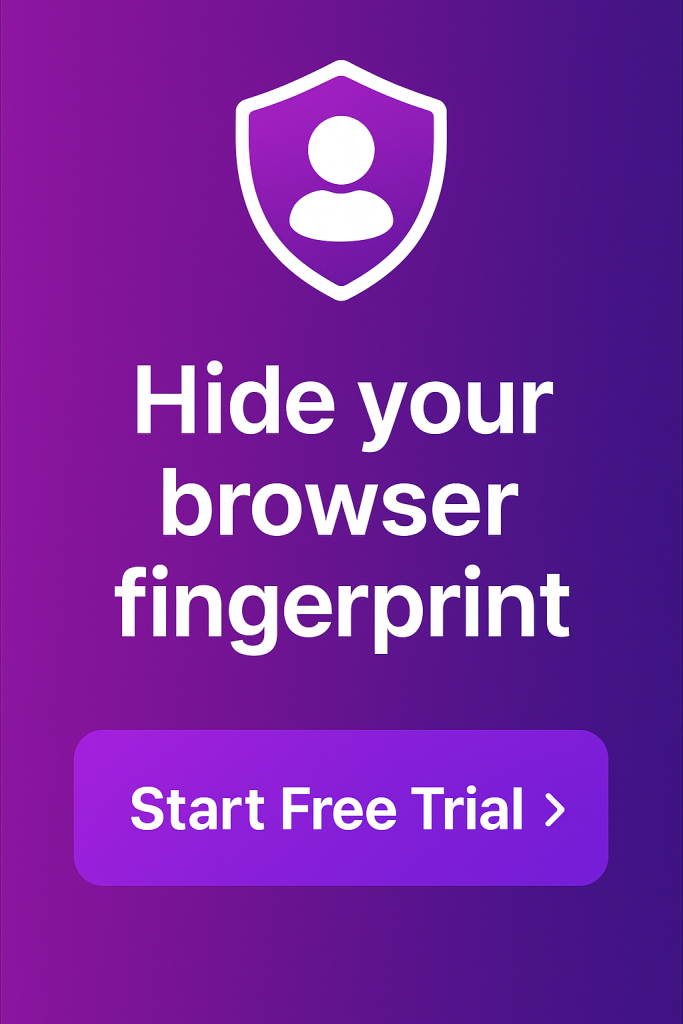All anti-detect browsers promise the same core features: safe Multi-accounting and Online privacy. But the way they go about it makes a big difference in user experience. Incogniton and Multilogin are two of the strongest competitors in this space, yet they serve slightly different types of users.
This piece breaks down the differences and similarities across the most important dimensions, so you can decide which one fits your needs.
TL:DR see table at the end of the article.
A Brief Overview of Both Browsers
Multilogin is one of the pioneers of the anti-detect browser industry. It was available for public use in 2015 and established itself as the go-to solution for those needing maximum fingerprint customisation and scalability. Its longevity has helped it establish itself as a market leader, particularly amongst enterprise clients, though its expensive pricing opened the door for leaner competitors.
User feedback reflects this dynamic, as Multilogin maintains a 4.4/5 Trustpilot rating, with reviews highlighting its robust technical capabilities but also noting its complexity.
Incogniton came much later, with its development starting in 2019 and its first working version presented in 2020. The team set out to fill the gap for an affordable, easy-to-use anti-detect browser that delivers advanced anti-fingerprinting capabilities to both individuals and large teams, while maintaining a privacy-first approach.
And so far, the team has done just that. Today, Incogniton holds a 4.6/5 Trustpilot rating, with users frequently praising its reliability, ease of use, automation features, and team-friendly collaboration tools.
Both browsers were built to solve the same problem: protecting users from privacy-intruding practices by online platforms like browser and canvas fingerprinting. The difference lies in their philosophy: Incogniton focuses on accessibility and ease, while Multilogin emphasizes control and scalability for professionals.
Incogniton vs Multilogin: Key Features Comparison
While both Incogniton and Multilogin aim to simplify multi-account management, their approaches and user experiences differ greatly. Here’s how they compare across setup, fingerprint control, automation, and collaboration:
1. Ease of Setup
The first challenge with any anti-detect browser is getting started. If the setup feels too complex, many users give up before they’ve even tested the features.
Incogniton takes a simplicity-first approach. From installation to your first profile, the process is quick and beginner-friendly. Its dashboard is clean and intuitive, with most of the heavy lifting — like generating realistic browser fingerprints — handled automatically. New users don’t need to worry about mismatched settings or advanced configurations. Features such as the bulk profile creator streamline the process further, letting you launch multiple accounts in minutes. This makes Incogniton especially appealing for freelancers, agencies, or anyone without a technical background.
Multilogin, while straightforward in terms of download and installation, introduces additional steps. New users must complete a Know Your Customer (KYC) verification process before gaining full access. Its dashboard is also minimalist and functional, but the absence of features like visible profile launch times may feel less user-friendly compared to Incogniton.
2. Browser Fingerprint Control
At the core of every anti-detect browser is its ability to disguise or “spoof” your digital fingerprint. This is where Incogniton and Multilogin diverge most in philosophy.
Incogniton is built around automation and realism. Instead of asking users to manually adjust dozens of settings, it generates pre-optimized, believable fingerprints by default. This minimizes the risk of mistakes. For example, pairing outdated hardware with a modern OS, could trigger suspicion. While some parameters can be customized (device model, OS, browser version, timezone, plugins, and more), most users can safely rely on the automated defaults. This balance makes Incogniton effective for non-technical users who want protection without complexity.
For more advanced users, Incogniton also provides granular control over these parameters, allowing customization of browser fingerprints, timezone data, screen resolution, and other identifiers. However, for most scenarios, the standard configuration remains both sufficient and secure.
Multilogin, by contrast, is designed for power users. It offers granular control over nearly every parameter: WebGL, canvas, audio, fonts, hardware specs, geolocation, time zones, even battery data. This depth allows advanced users to craft highly specific environments for tasks like scraping, testing, or mimicking particular devices. However, the freedom comes with risk — poorly configured settings can actually make profiles less believable.
Spoofed Layer | Incogniton | Multilogin |
Canvas/WebGL | Yes | Yes |
Audio Context Spoofing | No | Partial support |
Screen Resolution Spoofing | Yes | Yes |
WebRTC Masking | Yes | Yes |
Timezone/Geo Spoofing | Yes | Yes |
3. Automation and Proxy Integration
Scaling operations often means managing dozens or even hundreds of accounts. Without automation and reliable proxy integration, this quickly becomes unmanageable.
Incogniton positions itself as the automation-friendly choice even for non-developers. Built-in features like Paste as Human Typing simulate natural keystrokes, while the Synchronizer tool streamlines repetitive workflows. For advanced use cases, the Incogniton SDKs integrate seamlessly with Selenium, Playwright, and Puppeteer, three of the most widely used automation frameworks.
Proxy management is equally straightforward — users can add proxies at the profile level, test connections, and rotate them as needed. To lower the entry barrier, Incogniton even includes free proxies, helping new users get started without upfront costs.
Multilogin, on the other hand, is engineered for developers and enterprise teams. Its strength lies in its robust API library and compatibility with Selenium, Puppeteer, and Playwright, enabling highly customized automation setups. Proxy integration is powerful but more manual; configuring and testing require a stronger technical background.
4. Team Collaboration
Managing multiple accounts is rarely a solo effort. Whether it’s agencies, affiliate teams, or e-commerce operators, collaboration features determine how smoothly teams can work together.
Incogniton balances accessibility with team-friendly tools. It supports both local and cloud storage, giving users flexibility depending on their workflow. Local storage ensures faster performance and greater privacy, while cloud storage enables real-time collaboration across devices. Teams can securely share browser profiles and assign custom permissions — such as view-only, edit, or full access. This prevents accidental errors and makes it easy for small to medium-sized teams to coordinate without needing complex technical setups.
Multilogin takes a cloud-first approach. By default, profiles live in the cloud, which simplifies collaboration across time zones and remote teams. Access rights can also be customized, making it a reliable option for distributed enterprises. However, because cloud syncing is prioritized, performance may be slower in areas with weaker internet connectivity. While Multilogin does support local storage, it’s less emphasized compared to cloud usage.
Team Feature | Incogniton | Multilogin |
Role-based access | Available (Pro/Team plans) | Available (on Pro/Business plans) |
Profile sharing | Yes | Yes |
5. Pricing
For many users, price is the deciding factor, especially freelancers, small businesses, or teams just starting out.
Incogniton is designed to be accessible at every level. It offers a free trial plan supporting up to 10 browser profiles for about two months. This allows beginners to experiment without cost. Paid plans start at $19.99/month and scale gradually to support enterprise users managing thousands of profiles.
Multilogin, by contrast, does not offer a free plan. It provides a paid 3-day trial at €1.99 instead. Pricing is in euros, with payments accepted via MasterCard, Visa, and cryptocurrencies. Its entry-level pricing starts at €9/month for 10 profiles, €49/month for 50 profiles, and €79/month for 100 profiles. They also offer a custom plan where you can ask for the exact number of profiles and the kinds of features you want included in your package, starting at €300.
Plan | Incogniton | Multilogin |
Tier 1 Plan | $19.99/month (10 profiles) | €9/month (10 profiles) €49/month (50 profiles) €79/month (100 profiles) |
Tier 2 plan | $29.99/month (50 profiles) | — |
Tier 3 Plan | $79.99/month (150 profiles) | €159/month (300 profiles) |
Custom | Up to 5000 profiles, starts at $149.99/month | Starts at €300/month |
Trial Option | 2 months free trial with 10 accounts | No free; just 3 days trial @ €1.99 |
6. Performance and Reliability
Performance is crucial when juggling multiple accounts. Both browsers score high on reliability, with no major reports of crashes or data loss. Both are also Chromium-based, so they feel familiar to anyone used to Google Chrome in terms of speed and compatibility.
Incogniton is optimized for smooth profile switching and generally uses fewer system resources. Local profile storage contributes to faster performance, especially for users managing many accounts on the same machine. This makes it reliable for freelancers and small teams who need efficiency without lag.
Multilogin, however, offers something more: two custom browsers — Mimic (Chromium-based) and Stealthfox (Firefox-based). This dual-engine setup gives advanced users flexibility in simulating different browsing environments. However, because it emphasizes cloud syncing, performance can sometimes feel slower depending on internet speed or server load.
7. Support and Documentation
When things go wrong, responsive support and clear documentation can make all the difference.
Incogniton is often praised for its detailed knowledge center. Its users have access to written guides in its Knowledge Centre, step-by-step video tutorials on YouTube, and FAQs, all of which are written (or recorded) in simple language that makes onboarding smooth even for beginners. Developers also get an extensive API and SDK documentation to make their work easier.
Incogniton also has fast, accessible customer support. Users can reach the team via live Telegram chat or email, with response times that are typically quick.
Multilogin also provides extensive documentation, but it’s aimed at a more technical audience. Advanced topics such as API integration and fingerprint parameter adjustments are covered in depth, making it valuable for developers and enterprise teams. Support is available through multiple channels, but users have reported that response times can sometimes be slower compared to Incogniton.
8. Data Security and Privacy
For anti-detect browsers, trust is just as important as features. Both Incogniton and Multilogin are developed in Europe, which means they operate under the strict data protection standards of the GDPR. This legal framework enforces transparency, accountability, and safeguards around user data.
Incogniton takes a transparency-first approach. Its privacy policy clearly outlines how data is handled, and the company emphasizes protective measures such as encryption, penetration testing, and two-factor authentication (2FA). These steps are designed to keep user data secure, whether stored locally or in the cloud.
Multilogin also commits to strong security practices, including data encryption and regular updates.
Incogniton vs Multilogin: Full Feature Set Comparison
Evaluation Criteria | INCOGNITON | Multilogin |
Anti-Fingerprinting Tech | Advanced offers granular control over parameters | Standard. Offer granular control over parameters |
Operating systems compatibility | Windows, macOS | Windows, macOS, Linux, Android |
User Experience and Ease of Use | Beginner Friendly | Steep Learning Curve |
Multi-Accounting and Use Case |
|
|
Feature Set | 1. Free integrated proxies + paid proxy market 2. Cookie collector and other cookie management tools 3. Suite of proxy management tools 4. Bulk Profile Creator 6. Selenium, Playwright, and Puppeteer integration |
|
Company Trust and Location | The Netherlands, Amsterdam (Europe) | Estonia |
Quality of Support | Multiple channels, quick response times | Multiple Channels, relatively slow response times |
Security and Ongoing Updates | Clear data security practices | Clear data security practices |
Cost & Pricing | Robust starter and premium plans | Limited free plans, but offers customization |
Conclusion
Choosing between Incogniton and Multilogin ultimately depends on your goals, technical background, and scale of operations. Both tools are powerful anti-detect browsers and deliver on their promises of safe, reliable multi-account management regardless of the route they took.
Incogniton positions itself as the more budget-friendly, beginner-friendly solution, offering core essentials like unlimited browser profiles (on higher-tier plans), teamwork features, and smooth automation via Selenium, Playwright, and Puppeteer. Multilogin, on the other hand, is tailored toward enterprise-level users with sophisticated fingerprint management and granular controls but comes at a steeper price point.
If you’re a solo user or small agency, Incogniton likely covers all your needs without breaking the bank. If you’re part of a large-scale operation that requires the deepest fingerprint customization and enterprise support, Multilogin may be worth the investment. Ultimately, the best choice hinges on your scale, technical needs, and budget.
FREQUENTLY ASKED QUESTIONS
Is using Incogniton or Multilogin legal?
Yes, both tools are legal to use. What matters is how you use them. Running multiple accounts for legitimate business, advertising, or testing is fine. However, using them for fraud or prohibited activity can result in account bans or legal consequences.
Can I try Incogniton for free?
Yes. Incogniton offers a free trial with up to 10 browser profiles. It’s ideal if you want to test before committing.
How do I download and install the Incogniton browser?
You can download Incogniton directly from its official website. The process is straightforward: select the installer for your operating system (Windows or macOS), run the file, and follow the setup prompts. Once installed, you’ll be able to create and manage multiple browser profiles immediately. There’s no need for extra configuration to get started — the browser generates realistic fingerprints by default.
What is the best anti-detect browser?
There isn’t a single “best” anti-detect browser because it depends on what you need. Incogniton is often recommended for beginners and teams thanks to its simple interface, automation support, and generous free plan (up to 10 profiles). GoLogin is preferred by more technical users who want deeper control over fingerprint parameters. The best choice comes down to budget, team size, and how much customization you require.
Is Tor an anti-detect browser?
No. Tor is a privacy-focused browser that anonymises your internet traffic by routing it through multiple relays. It hides your IP address and makes tracking more difficult, but it does not create or manage unique browser fingerprints in the way anti-detect browsers do. Anti-detect browsers like Incogniton, Multilogin, or GoLogin, on the other hand, generate distinct, realistic fingerprints for each profile, which is crucial for multi-account management.
Can I use Incogniton or Multilogin for e-commerce, social media, or ad verification?
Yes, both are designed for multi-accounting and identity protection across use cases like e-commerce store management, running multiple ad accounts, or scaling social media activities. The difference lies in how much customization you need. Incogniton simplifies setup, while Multilogin allows highly detailed fingerprint tweaking.
How can I know if my browser is being tracked?
You can test your browser’s fingerprint on websites like Pixelscan or Whoer. These tools show how much identifiable information your browser leaks, such as IP, device type, and fingerprint uniqueness.
Anti-Detect Browser for Multi-Account Management
Manage unlimited virtual profiles for easy multi-account management. Safe and anonymous. Ideal for teams and individuals. Download and try for free now!



